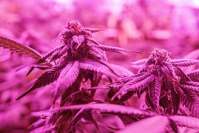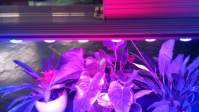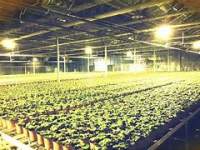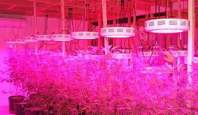The advantages of dimmable LED plant lights
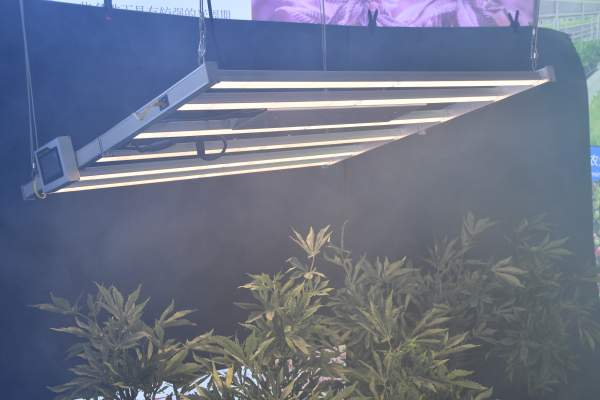
There are some plant lights that can adjust the spectrum, and the user can turn on or off the red and blue light separately through several separate knobs. Some growers think this is unnecessary, but some growers think that reducing the red light can reduce the distance between the nodes on the plant stem. After years of trials and tests, growers believe that the best way to make plants shorter is to hang the lamps lower. It is necessary for the plants to try to get close to the tall lamps.
The wavelength of the LED plant light can be set according to customer needs and customized according to various plant growth conditions and needs. The plant light has a wide variety of wavelengths and has a large room for adjustment. It can be adjusted according to the preferences of various plants. Plant lights are suitable for lighting various plants. Plant photosynthesis of light does not need to look at color temperature and lumens.
Seedlings illuminated by blue LEDs have fewer leaves and are slender as a whole. The seedlings illuminated by pink LEDs have relatively large leaves and the overall plant growth is balanced. Different types of plants have somewhat different light wavelengths that affect their growth. In the future, it is still necessary to carry out experiments including adjustment of exposure and time in agricultural test sites.
Blue light can promote the growth of green leaves; red light is conducive to flowering and fruiting and prolonging the flowering period! Comparing the seedlings with three different lightings, it was found that the seedlings with red LED lighting grew the slowest than the other two seedlings and had the smallest overall size.
The physiological effect of the spectral range on plants is 280 ~ 315nm ---> The impact on the morphology and physiological process is very small. 315 ~ 400nm ---> Chlorophyll absorbs very little, which affects the photoperiod effect and prevents the elongation of the stem from 400 ~ 520nm (blue) – >The absorption ratio of chlorophyll and carotenoids is the largest, and it has the greatest impact on photosynthesis. 520 ~ 610nm (green) -> the absorption rate of pigment is not high 610 ~ 720nm (red) -> the absorption rate of chlorophyll is low, which has a significant impact on photosynthesis and photoperiod effects Significant influence 720 ~ 1000nm ---> Absorption rate and low, stimulate cell elongation, affect flowering and seed germination> 1000nm ---> converted into heat. From the above data, the effect of light of different wavelengths on plant photosynthesis is Different, the light required for photosynthesis of plants has a wavelength of about 400 ~ 720nm. The light of 400 ~ 520nm (blue) and 610 ~ 720nm (red) contribute the most to photosynthesis. The light of 520 ~ 610nm (green) has a very low rate of absorption by phytochromes.
When plant lights are used to fill plants with light, the height from the leaves is generally about 0.5 meters, and continuous exposure for 10 hours a day can completely replace the sun. The effect is very significant. The growth rate is almost 3 times faster than that of ordinary plants that grow naturally. It solves the problem of lack of sunlight in winter, promotes the chlorophyll, anthocyanin and carotene needed in plant photosynthesis, and makes fruits and vegetables 20% earlier Harvesting increases the yield by 30% to 50% and improves the sweetness of fruits and vegetables.
Compared with LED plant lights, dimmable has obvious advantages. The risk of adjusting the spectrum of the LED is far less than the benefits of adjusting the appropriate spectrum to plants. LED plant lights may have more knobs and can even control every kind of light. So that growers can call up the best and most suitable spectrum for their plants. These adjustable LED plant lights may uncover the spectral mixing ratio required by each plant, thereby promoting the development of LED plant lights and producing growth lights suitable for various plants. In addition, commercial growers who grow a variety of plants can benefit from it, because they can find specific lamps suitable for their specific plant growth.
According to the above principles, the plant lights are made into three forms of red and blue combination, full blue, and full red to provide light of two wavelengths of red and blue, covering the wavelength range required for photosynthesis. In terms of visual effects, the red and blue plant lights are pink. As for white LED lamps, the most common use is to use blue LED crystals to excite yellow phosphors, which compositely produces a visual white light effect. In terms of energy distribution, there are two peaks in the blue region at 445nm and the yellow-green region at 550nm. The 610 ~ 720nm red light required by plants is very lacking.
This explains why the white LED is unfavorable for plant growth. The ratio of red and blue spectrum of plant lights is generally between 5:1 and 10:1, and the ratio of 7-9:1 is usually optional. When using plant lights to illuminate plants, the height from the leaves is generally about 0.3-0.5 meters.
The total cost of buying an LED plant light: Please consider what cost LED has reduced for you. The price of an LED plant light may be 3 times or more expensive than a HID due to different functions. But these initial investments can be offset by lower care costs and electricity bills. The cost recovery time of LED plant lights is actually much shorter than that of HID. This is because when using LEDs, many of the equipment necessary for using HID can be reduced or eliminated. These reduced electricity bills are even more than the electricity bills saved by LEDs.
According to the above principles, the plant lights are made into three forms of red and blue combination, full blue, and full red to provide light of two wavelengths of red and blue, covering the wavelength range required for photosynthesis. In terms of visual effects, the red and blue plant lights are pink. As for white LED lamps, the most common use is to use blue LED crystals to excite yellow phosphors, which compositely produces a visual white light effect. In terms of energy distribution, there are two peaks in the blue region at 445nm and the yellow-green region at 550nm. The 610 ~ 720nm red light required by plants is very lacking.
This explains why the white LED is unfavorable for plant growth. The ratio of red and blue spectrum of plant lights is generally between 5:1 and 10:1, and the ratio of 7-9:1 is usually optional. When using plant lights to illuminate plants, the height from the leaves is generally about 0.3-0.5 meters.


